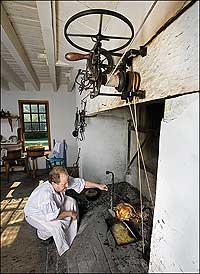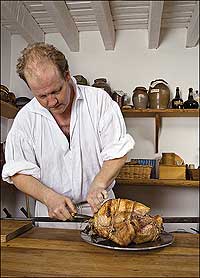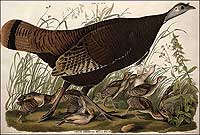Page content
A Much More Respectable Bird... a Bird of Courage
by Andrew G. Gardner
A Short History of the Turkey
There may be as many myths and legends, contradictions and questions, about the history of the turkey as any gastronomic icon. Who discovered the turkey and took it to Europe? How on Earth did it pick up a name from a country halfway around the globe? In addition, how did its name achieve prominence as a word signifying failure? Yes, the poor old turkey needs quite a bit of explaining.

In the kitchen of Colonial Williamsburg's Governor's Palace, Historic Foodways interpreter Rob Brantley bastes a bird roasting on the spit.
When the Pilgrims stepped off the Mayflower on December 11, 1620, finding a last-minute holiday turkey was not on their to-do list. New England's thanksgiving would not be invented for another year, and the Pilgrims did not celebrate Christmas, so the turkeys scurrying around the Massachusetts woods should have breathed a sigh of relief. The settlers and the Indians waited a year to give thanks for a harvest, and the Bible, the new arrivals said, did not sanction Christmas. Even up to near the middle of the nineteenth century, in the northeastern states, Christmas was just another workday.
Since then America has more than made up for this early lapse.
Put aside Thanksgiving for a moment. Every December 25, to great fanfare, millions of roasted, plump Christmas turkeys paraded to festive tables across the United States. If Benjamin Franklin were still with us, this annual sacrifice would bring tears to his eyes. For rather than lumping the turkey along with the mistletoe, the holly, and all the rest of the jingle-bell paraphernalia, Franklin saw the noble turkey as more than Christmas fare. After independence, an early Congress debated the matter of a fitting symbol for its new country, settling on the bald eagle. Franklin was the United States' ambassador to France and received a newly minted seal of office reflecting the choice. It drew sniggers because the eagle, it was said, looked more like a turkey. Franklin wrote:
I am on this account, not displeas'd that the Figure is not known as a Bald Eagle, but looks more like a Turk'y. For in Truth the Turk'y is in comparison a much more respectable bird, and withal a true original native of America.... He is, (though a little vain and silly, it is true, but not the worse emblem for that,) a Bird of Courage, and would not hesitate to attack a grenadier of the British Guards, who should presume to invade his Farm Yard with a red Coat on.
With that letter, a pompous, puffed-up bird with an appearance so strange and inelegant that it belongs, with the camel, in the list of animals designed by committee, was elevated to a rank well above its station, where it remains.
Nevertheless, the turkey had a long and distinguished history before being promoted for America's national emblem. Centuries before Christopher Columbus reached the New World, the Aztecs had domesticated a wild game bird that we call the turkey, but they called huexolotl. The turkey was so important to the Aztecs as a source of food that the Indians regarded the bird as a god. There were two religious festivals a year in the turkey's honor.
When the Spanish arrived in the earliest years of the sixteenth century, they were at a loss what to name the strange bird ...and settled on calling it "a kind of a peacock with great hanging chins." The bird's reputation for delicious, fine-textured flesh and distinguished plumage, as well as a comical appearance, was soon talked about in the court circles of Madrid and Seville. Who sent the first birds back to Spain is unclear. Most likely, it was Columbus after his fourth transatlantic visit in 1502, when he visited Cape Honduras. Some historians say Hernando Cortes, the swashbuckling Spanish conquistador, deserves the credit. But Cortes began his Mexican adventures in 1519, eight years after King Ferdinand sent out instructions that every Spanish ship returning from the New World should bring back ten turkeys, "half males, and the other half females ...because I desire that there be bred here some cocks and hens of those which you have there and were brought from Tierra Firme."
There are two wild species of turkey, members of the pheasant family that evolved in the New World about eleven million years ago. The Ocellated turkey—Agriocharis ocellata—is native to the jungles of the Yucatan and Guatemala. The other, more familiar species is the granddaddy of all present-day gobblers—Meleagris gallopova—and ranged from southeastern Canada to Mexico. Like pheasant and grouse, wild turkeys can burst into a short flight that clocks up to fifty-five miles per hour. On the ground they are no slouches either, running at up to thirty miles per hour. But turkeys are bred nowadays for brawn, not speed. According to the Guinness Book of Records, the biggest-ever turkey weighed eighty-six pounds. With a payload like that, it would have a hard enough time standing on its pins, let alone winging its way skyward.
The turkey's alleged stupidity has given rise to derogatory terms in the English language. Reputable poultry researchers talk of turkeys standing in the rain looking upward to heaven—no one is sure why—and not having the sense to go inside out of the rain. Raindrops block their nostrils, and the result is death by drowning—surely the ultimate in stupidity. Yet wild turkeys have a reputation for craftiness.
Like the Aztecs to the south, the North American Indian tribes regarded the turkey as a powerful spiritual symbol. They prized its breast feathers as an alternative to goose down for warm winter cloaks. Southwestern tribes, believing the turkey to be the guide that ushered the dead into the next world, buried their loved ones in turkey-feather robes. But with the advent of the Europeans, the turkey's prospects turned. They were still revered—but now as an easily obtained meal. Early reports talk of hunters shooting 100 birds in a day—day after day. Hens sold for six cents, twelve-pound cocks for a quarter. Such carnage was unsustainable. From an estimated eleven million birds, wild turkeys were nearly wiped out. In 1930, a nationwide census counted fewer than 30,000 birds. After more than half a century of conservation, the wild turkey population has recovered to more than five million birds. But compare that to the annual United States domestic turkey production of about 270 million birds.
The spread of the delectable turkey around Europe quickly followed its introduction into Spain. England gawked at its first turkey in the 1520s—introduced, it is said, by William Strickland of East Yorkshire after a visit to the New World with John Cabot. In later life, Strickland's perspicacity appears to have been honored with the award of a grant of arms—a family crest—that sported a heraldic "turkey-bird in his pride proper." As elsewhere in Europe, the bird proved a great hit in England. Hitherto, the high-end feathered diet of English aristocrats had included such tough and chewy morsels as cormorants, swans, cranes, herons, storks, and another, now critically endangered bird known as the Great Bustard. Who knows, but the arrival of the turkey probably helped save that species from extinction.
According to Thomas Tusser's 1570 Five Hundred Points of Good Husbandry, turkey meat was now part and parcel of England's Christmas celebrations, at least for the well off. Such was the demand, that farmers from Norfolk, eighty or more miles distant, would drive their thousand-strong turkey flocks to market in London on foot, reportedly creating the first traffic jams on the streets of the English capital. According to local legend, each turkey wore custom-made leather booties to protect its feet on the long march south to the slaughter. It sounds too cute to be true.
By 1541 eating turkey was so popular that when Thomas Cranmer, the Church of England's top archbishop, introduced a sumptuary law to restrict the consumption of meat dishes by his underlings, turkey was on the hit list. He said "of the greater fishes or fowles, there should be but one in a dish, as crane, swan, turkeycocke, haddocke, pyke, tench."

Brantley carves the bird, a favored holiday dish from the beginning, though it is not certain the Pilgrims partook on the first Thanksgiving.
In Italy, the Venetian senate passed similar laws to curtail excessive feasting, and turkey—this time along with pigeon—was outlawed. But the Venetians did not take kindly to being told what not to eat and apparently continued to evade the law by carving the birds in secret and making enormous pies with the meat. One similar, monster English pie made in the northern cathedral city of Durham was touted as having used up 100 turkeys in the making.
The turkey's European invasion was virtually complete by 1560. The novelty of the birds made them status symbols for the rich and famous. With European nobility fond of turning their estates into zoological extravaganzas, all manner of exotic birds and beasts were sent home from the New World, and what more intriguing species to join the now passé Indian peacock than a strutting, gobbling turkey-cock? Particularly if you had not seen one before. It looked magnificent. What's more, after you tired of the male's aggressive nature and unprovoked attacks on unsuspecting visitors, particularly those dressed in red, it made for a good supper.
Put there were questions about what to call it. Once the bird began to strut its stuff across the European continent, every different language settled on a different name. The result was a muddle. Adding to the confusion was that people mistook the word for "turkey" as referring to the equally odd-looking guinea-fowl that were being imported from West Africa about the same period. The French called the turkey coq d'Inde, meaning rooster of India. This was shortened to dinde—the modern French word for turkey—but as we know, it did not come from India.
Columbus had sown the seeds of geographic confusion with his assessment that the New World was India. Nevertheless, the name-that-bird quest did not end there. In Arabic, the turkey was called the Ethiopian bird; to the Lebanese—the Abyssinian cock; the Portuguese called it the Peru bird, though there never was a turkey in that country either; in Greek it went by the name gallopoula, or French girl. Presumably, the Greeks got their first turkeys from the French. But it gets curiouser. In Malay, a turkey is ayam belanda, or Dutch chicken, though the Dutch and the Germans call it a Calicut chicken, after a southwest Indian seaport; and to cap it all, the Turks call the bird hindi, which sounds suspiciously Indian to me.
Two hundred years later, when the Swedish naturalist Carl Linnaeus tried to classify the turkey and its relatives in the natural scheme of things, he did not get it right either. He cobbled together the Latin name Meleagris gallopova. Well, meleagris is a guinea fowl, gallus is a chicken, and pova is a peacock—a mishmash if ever there was one. All in all, the turkey had Linnaeus stumped.
But how did the English-speaking world make the mistake of calling a North American bird a turkey when everyone else was heading off in the direction of India, Peru, or Ethiopia? The first explanation was that Columbus called it "turkey" after the noise it makes: tuka, tuka. Similarly, North American Indians supposedly called it turkey after the sound they thought it made—firkee—though it seems a stretch from firkee to gobble-gobble. It has also been suggested that Luis de Torres, a doctor who sailed with Columbus, called the bird tukki, which in Hebrew means "big bird."

An engraving from Audubon's painting of a hen with her poults, or chicks, circa 1827–30. Wild turkeys can run thirty miles an hour and fly, briefly, at fifty-five. By 1930, they had been hunted to near extinction but have recovered to five million today.
Perhaps the most plausible explanation is that English traders who specialized in trading with the Ottoman Empire, which included Turkey, were called Turkey merchants, and they had tasted roast turkey in Spain or Portugal on their way to and from the eastern Mediterranean. With an eye to a profit, the traders brought birds back to England, augmenting those introduced by Strickland. But the name turkey stuck.
When the Pilgrims disembarked from the Mayflower in 1620, along with livestock that reportedly included some domesticated turkeys, it didn't take them long to realize that the wheel had turned full circle, and the native birds they admired and hunted were distant cousins of their own domestic turkeys.
Of all the hallowed stories of the Pilgrim fathers, the most venerable is that of their Thanksgiving dinner—particularly the turkey. Every American kid knows the story backwards. But sad to say there is no real evidence that turkey was on the menu that day.
Colonist Edward Winslow wrote:
Our harvest being gotten in, our governour sent foure men on fowling, that so we might after a speciall manner rejoyce together, after we had gathered the fruits of our labours; they foure in one day killed as much fowle, as with a little helpe beside, served the Company almost a weeke, at which time amongst other Recreations, we exercised our Armes, many of the Indians coming amongst us, and amongst the rest their greatest king Massasoyt, with some ninetie men, whom for three dayes we entertained and feasted, and they went out and killed five Deere, which they brought to the Plantation and bestowed on our Governour, and upon the Captaine and others.
No mention of turkeys, except in an ambiguous account written years later by the governor, William Bradford, who makes no specific connection between the turkey and the 1621 festivities. He wrote:
They begane now to gather in ye small harvest they had, and to fitte up their houses and dwellings against winter, being all well recovered in health & strenght, and had all things in good plenty; ffor as some were thus imployed in affairs abroad, others were excersised in fishing, aboute codd, & bass, & other fish, of which yey tooke good store, of which every family had their portion. All ye somer ther was no want. And now begane to come in store of foule, as winter approached, of which this place did abound when they came first (but afterward decreased by degrees). And besids water foule, ther was great store of wild Turkies, of which they tooke many, besids venison, &c.
Bradford had "sent four men fowling" to find food, but whether they returned with turkey to grace their table is not clear. It hardly matters. The tradition is still revered, and turkey is still served. Only nowadays, there is no doubt about what it is we are eating.
Andrew Gardner, who writes on Canada's Salt Spring Island, contributed to the autumn 2006 journal an article about colonial ferries. This article was originally published in the Christmas 2005 edition of the Colonial Williamsburg Journal.
Read more articles from the Foundation's journal, “Colonial Williamsburg”.
